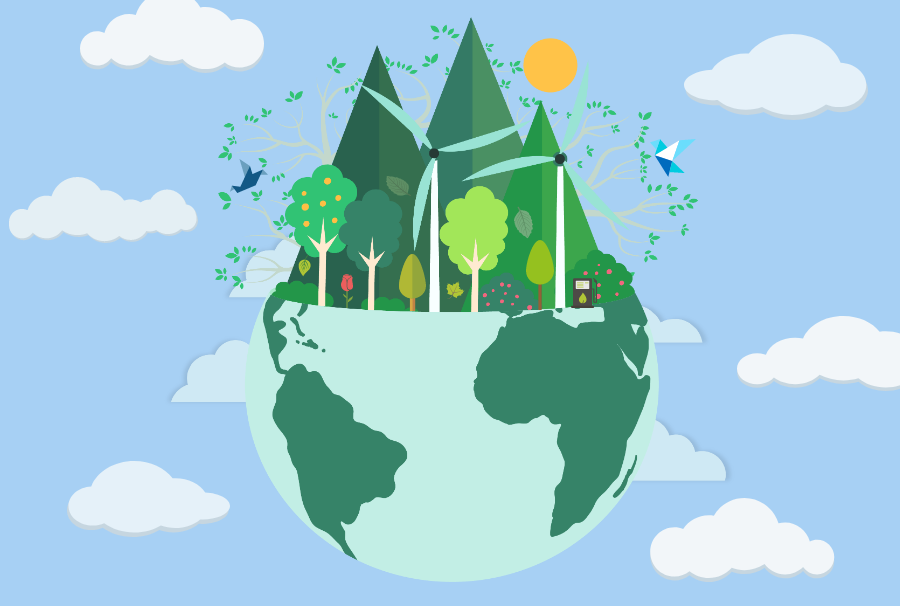Going green: raising my environmental sustainability for two weeks
I started becoming acutely aware of my own individual effect on the environment, and in the ensuing months of this self-reflection, have begun a journey towards creating an environmentally sustainable lifestyle.
January 29, 2021
As a teenager, I practically live on long, hot showers, cheap online shopping and meat-filled meals. But as much as I cherish these luxuries, I know some of my favorite vices are detrimental to our planet.
My growing environmental-consciousness reached a tipping point after several members of Congress revealed their proposal for a Green New Deal. The bold legislative agenda, and warnings about the dire state of climate change prompted me to reflect on my own routines. I started becoming acutely aware of my own individual effect on the environment, and in the ensuing months of this self-reflection, have begun a journey towards creating an environmentally sustainable lifestyle.
The first step of many was to cap the length of my showers at five minutes. A typical showerhead sprays about five gallons of water per minute, so compared to my usual 25 minute, scalding hot shower –– complete with off-key singing –– five minute showers are a significant cutback in water usage. The actions of transporting the water to homes and heating it up for showers require immense amounts of non-renewable energy.
Instead of immediately cutting off 20 minutes, I decided to ease my way towards my goal. My starting point was 10 minutes, and I steadily dropped more time from there. Though it took uncomfortable changes, and the loss of my solo performances, I was able to chop my showers to a breezy three to five minutes within two weeks.
Shower lengths, while a good start, were only the beginning of creating a sustainable lifestyle for myself; I still had to address my other harmful tendencies — like my online shopping addiction.
My obsession consisted of hours spent surfing the web for stores with the cutest clothes at the cheapest prices. But many of the websites I used to find these clothes, including Shein and Zaful, were neither ethical nor environmentally friendly.
Many of these sites are examples of “fast fashion,”. They sell inexpensive clothing produced rapidly by foreign, mass-market retailers in response to the most recent fads and trends. Fast fashion producers value speed over sustainability, leading to increased amounts of fabric scraps and clothing in landfills. Landfills are the third largest source of human related methane emissions, and the dye runoff from these landfills can pollute water supplies.
To curb my desire for cheap shopping, I tried thrifting –– buying pre-owned clothes to reduce the ever-growing fabric piles in landfills. A few of my friends and I planned an excursion to Unique, a thrift store in Falls Church, Virginia. There, I found one of my favorite items of clothing –– a multicolored, striped, knit cardigan that I’ve lived in ever since. My friend and I browsed aisles filled with clothes of every size, fit, color and style — almost always priced under $10. Along with satisfying all of my shopping desires, thrift stores tell unique stories. With each item I purchased, I tried to imagine who owned the garment and what experiences they went through. For example, sifting through Unique’s dress rack, I found a floral prom dress; I can imagine the bubbly teenager that had worn it to their senior prom.
Next, I knew I had to address my plastic habits, specifically my daily usage. The large amounts of plastic humans discard has devastating effects on the environment, disrupting the ocean’s wildlife and food chains as a non-biodegradable pollutant. At first, I thought, ‘I’m a proud reusable Hydro Flask owner, what more can I do?’ –– but I decided to document my own plastic usage just in case there was room for improvement. My consumption rates alarmed me.
I watched in horror as my total plastic usage skyrocketed: leftover dinners covered with saran wrap, snacks for long car rides packaged in Ziplocks, and groceries from weekly shopping trips held in store-supplied bags all added up together. Immediately, I started to devise ways to eliminate most of these tendencies.
A simple shift to tupperware supplanted the need for wasteful plasticware. And, after doing a little research, I found that by utilizing reusable bags while grocery shopping, I can save up to 22,000 plastic bags over the course of my life. Not to mention, reusable bags can hold way more groceries than the store-supplied plastic ones.
The final adjustment I made involved changing my diet. I began dramatically decreasing my weekly meat consumption. As a competitive swimmer, my day-to-day meals are constantly filled with protein, typically in the form of turkey burgers and grilled chicken. But a quick look into the meat production industry yields an uncomfortable truth: animal agriculture is responsible for up to 18% of global greenhouse emissions.
I haven’t become full-on vegetarian or vegan yet, but cutting out meat for a few days a week was nowhere near as impossible as I had anticipated. I ingested my valued protein through other means like quinoa, chickpeas and greens, and didn’t suffer any detrimental effects to my physical well-being.
At the end of the day, increasing your own environmental sustainability doesn’t have to be complicated, even if it may seem impossible to break away from your environmentally damaging habits. My journey also revamped my lifestyle to include new practices, and, past the environmental aspect, has made me more open-minded to future changes. I’ve retired from my unsustainable habits, and I don’t plan on going back.







